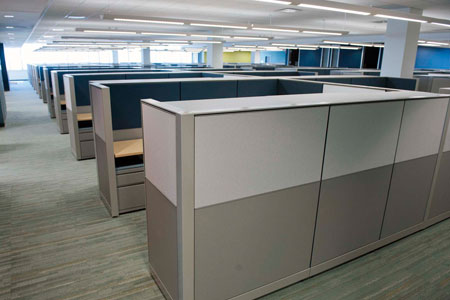
|
March 2012
|
|
|
The U.S. Department of Energy's Thomas Jefferson National Accelerator Facility
|
|
Lab Prepares to Open Cutting-Edge
|
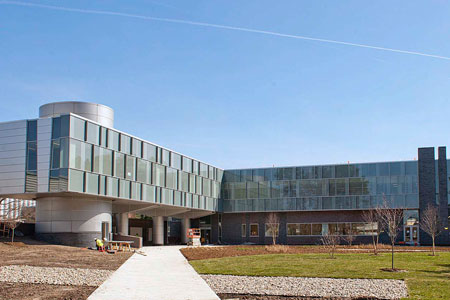 The new Technology and Engineering Development building at Jefferson Lab will open soon. The TED will provide office and research spaces for cutting edge design and fabrication work.
A new era is set to begin at Jefferson Lab with the opening and occupancy of the new Technology and Engineering Development (TED) building. The SRF Institute staff from the Test Lab will be the first to move into the new building. Moves will begin after clean-up and moving crews complete the tasks of cleaning, and shifting furniture, equipment and supplies into the TED. "The opening of the TED is a huge leap forward for the lab," said Lab Director, Hugh Montgomery. "The new office and research spaces will ensure that we remain at the forefront of design and fabrication for superconducting radiofrequency technologies; it will be a valuable asset as we prepare the lab's future and the 12 GeV experimental program."...... more |
|
|
Nuclear Physics Enables Measure of
|
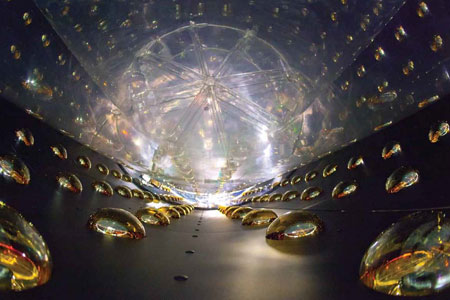 Neutrino Net: When operating, this tank is filled with liquid that reveals neutrinos through faint, greenish-blue flashes of light. The flashes are collected by sensitive components, called photomultiplier tubes (domes) that measure more than a thousand neutrinos every day. Photo: Berkeley Lab Public Affairs
Tiny flashes of light deep in the mountains are slowly illuminating some of the most ubiquitous, yet also most elusive particles in the universe: neutrinos. Neutrinos are some of the least understood of the subatomic particles. There are three flavors of neutrinos, called the tau neutrino, the muon neutrino and the electron neutrino. Each neutrino also has a partner, called an antineutrino. Experiments around the world are shedding light on all six neutrinos to better understand the origin of matter in the universe. Untold numbers of neutrinos are forged every second in the hearts of stars, including our sun – and they're the only particles originating in the heart of the sun that can travel through it without being changed. That's what makes neutrinos so mysterious and difficult, yet so tantalizing, to study: They zip right through most visible matter in the universe, only rarely interacting with the matter they encounter. To study neutrinos, scientists had to find a way to glimpse these very rare interactions. Members of the Daya Bay Reactor Neutrino Experiment collaboration, including Jefferson Lab Deputy Director for Science and Technology, Robert McKeown, came up with a clever way of studying the elusive neutrino. They put six exceedingly sensitive detectors near a prolific source of antineutrinos, filled them with material that antineutrinos are most likely to interact with, and waited. The first result from this method has pinned down a key property of the electron antineutrino for the first time. The prolific source of antineutrinos for the experiment are the powerful reactors of the China Guangdong Nuclear Power Group in southern China. The group runs two facilities that are located on Daya Bay in southern China. The Daya Bay and Ling Ao facilities are powered by six nuclear fission reactors, which split apart the nucleus of the atom to provide power. As the Governor's Distinguished CEBAF Professor in the College of William & Mary's physics department, McKeown leads the William & Mary team on the experiment. The group is responsible for keeping track of the number of neutrinos being emitted by the two reactors. 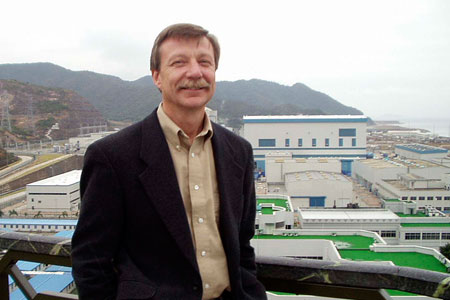 The Daya Bay and Ling Ao nuclear power reactors, pictured here behind Jefferson Lab's Robert McKeown, are located roughly 55 kilometers from Hong Kong.
"In nuclear fission, the nucleus breaks up into two pieces and some debris. These two pieces are radioactive, and they emit particles in that radioactive decay, and some of the particles are antineutrinos," McKeown explains. "Typically, six anti-neutrinos are emitted for every nucleus that is fissioned. So it's a very well-calibrated process. If you know the power of the reactor, you know how many antineutrinos are being emitted by that reactor." Three experimental halls at Daya Bay house identical detectors for capturing and detecting the passage of neutrinos. Before coming to Virginia, McKeown led a group at The California Institute of Technology that built many important components for the detectors. His William & Mary group also had substantial responsibility for the installation, commissioning and calibration of the detection apparatus. The antineutrino detectors consist of a material that some neutrinos will interact with, as well as a system for detecting those interactions. "We detect the neutrinos using material called liquid scintillator; it's a clear fluid. There's 20 tons of it in each of these detectors," McKeown says. "The clear fluid contains hydrogen. The antineutrinos change the proton in the hydrogen nucleus into a neutron and a positron. The positron is the anti-particle to the electron." The positron slows down in the liquid and annihilates an electron, producing a flash of light. "The neutron bounces around in the detector for a while and then captures on another nucleus, a special nucleus we put in the liquid called gadolinium, and it emits more light. The flashes are converted into visible light by the special properties of the liquid scintillator," McKeown says. "So you see two flashes of light as the signal, and that's the signal for the antineutrino." Sensitive detectors lining the walls of the detector system, called photomultiplier tubes, collect the greenish-blue light. The detectors measure the total intensity and energy in each flash. These identical systems allow experimenters to compare the number of neutrinos they see in the three experimental halls. Two of the halls are located just half a kilometer from the reactor facilities, while the third hall is about two kilometers away. Of the millions of quadrillions of antineutrinos spewed by the reactors every second, the twin detectors in the near halls collect information on a mere thousand or so neutrinos each day. Even fewer appear in the far hall. The experiment records the precise difference in flux and energy distribution between the near and far detectors. Some neutrinos may disappear because they are morphing into a different type of neutrino. This morphing, or oscillation, has been seen in neutrinos before. "The type of experiment that we're doing is called a disappearance experiment, because we're looking for the electron antineutrinos to disappear," McKeown explains. "They presumably disappear, because they are oscillating into muon antineutrinos and tau antineutrinos. But we don't detect those. We just detect that electron antineutrinos are missing." 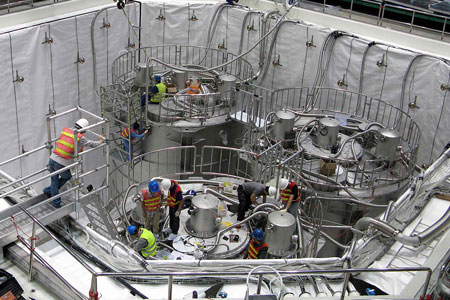 The Daya Bay experimental halls are buried deep inside a nearby mountain to shield the detectors from cosmic rays, and the detectors are submerged in pools of water to shield them from radioactive decays in the surrounding rock. Despite these measures, the detectors also detect energetic cosmic rays, which are carefully excluded from the data. Photo: Daya Bay collaboration
Scientists refer to the pattern of how neutrinos oscillate into other flavors in terms of angles. The angle for the type of neutrino produced by the nuclear reactors at Daya Bay, the electron antineutrino, is referred to as θ13, or theta-one-three. The Daya Bay experimenters aim to be the first to obtain a precise measurement of θ13. "This is the most sensitive of all the other neutrino experiments. Ours is designed to be sensitive to the 1 percent level," McKeown says. On March 8, the Daya Bay Reactor Neutrino Experiment collaborators announced that they had a first measure of the quantity with just 55 days of data. They found that roughly 6 percent of the neutrinos morph into another flavor after passing through the near detectors and before reaching the far detectors. McKeown says although not all of the data are in yet, there is now enough to clearly indicate that θ13 is not zero, a key measurement for understanding the evolution of matter in the early universe. "If you look around the universe now, essentially it's all matter and very little anti-matter. And this is a mystery. We've been trying to figure out for a long time why there's matter and not anti-matter," McKeown explains. The fact that the electron antineutrino does oscillate into other neutrinos is an important observation that supports some theories of how matter came to dominate in those first few minutes after the Big Bang. It's thought that neutrinos existed in the early universe as free particles long before any others. Since neutrinos interact only weakly, it's thought that they were the first ones to break away from the newly created ball of matter and energy that became the universe after the Big Bang. "They could explain why we are here as matter, as opposed to matter and anti-matter that just annihilate and go away. So, it's actually quite a fundamental part of physics," McKeown says. The Daya Bay experiment continues to collect data and is expected to have a final, precise measurement of θ13 in a few years. This new result has been submitted to Physical Review Letters and is available on arXiv.org. The Daya Bay Collaboration web page also contains more technical information regarding the announcement. For non-technical presentations of the recent result, see the William & Mary news release, the Interactions news release, and the article published by ScienceNOW, featuring Bob McKeown. The collaborating institutions of the Daya Bay Reactor Neutrino Experiment are Beijing Normal University, Brookhaven National Laboratory, California Institute of Technology, Charles University, Chengdu University of Technology, China Guangdong Nuclear Power Group, China Institute of Atomic Energy, Chinese University of Hong Kong, Dongguan University of Technology, Joint Institute for Nuclear Research, University of Hong Kong, Institute of High Energy Physics, Illinois Institute of Technology, Iowa State University, Kurchatov Institute, Lawrence Berkeley National Laboratory, Nanjing University, Nankai University, National Chiao-Tung University, National Taiwan University, National United University, North China Electric Power University, Princeton University, Rensselaer Polytechnic Institute, Shandong University, Shanghai Jiao Tong University, Shenzhen University, Siena College, Tsinghua University, University of California at Berkeley, University of California at Los Angeles, University of Cincinnati, University of Houston, University of Illinois at Urbana-Champaign, University of Science and Technology of China, Virginia Polytechnic Institute and State University Blacksburg, University of Wisconsin at Madison, College of William and Mary, and Sun Yat-Sen (Zhongshan) University. By Kandice Carter |
JLab to Participate in Statewide Tornado Drill on March 20 |
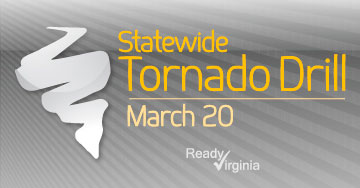 Last year, 51 tornadoes hit Virginia, the second highest number on record. Ten people died, more than 100 were injured, and 212 homes and 17 businesses were destroyed. Nearly every part of the state was affected, according to the Virginia Department of Emergency Management. All Virginians need to practice taking cover from tornadoes; and VDEM is providing that opportunity for everyone during a Statewide Tornado Drill, set for Tuesday, March 20, at 9:45 a.m. Jefferson Lab plans to participate in the tornado drill, according to Tina Menefee, JLab's emergency manager. Every home, business, organization, school and college is being encouraged to hold a tornado drill, according to Laura Southard, VDEM Public Outreach coordinator. "And if you can't participate at that time, then choose another time or date – the most important thing is to have a drill," Southard adds. To start the March 20 drill, the National Weather Service will send out a Tornado Warning drill message at about 9:45 a.m. that will trigger a tone alert and message on the NOAA Weather Radio system. This will prompt local radio and TV stations to broadcast the drill message. Know the Terms Describing Tornadic Activity
Tornado: A violently rotating column of air, underneath a cloud formation, and often (but not always) visible as a funnel cloud that is in contact with the ground and the cloud base. A tornado may produce rotational winds ranging from speeds below that of hurricane to more than 300 mph. In Virginia, tornadoes may develop in conjunction with hurricanes but can develop anytime, anywhere, suddenly and without warning when the weather is in a state of fluctuation. Tornado Watch: a tornado is possible in your area. You should monitor weather-alert radios and local radio and TV stations for information. Tornado Warning: a tornado has been sighted in the area or has been indicated by National Weather Service Doppler radar. When a warning is issued, take cover immediately. This information is from VDEM's Tornado Overview webpage at: http://www.vaemergency.gov/prepare-recover/threat/tornadoes/ In response to the drill announcement, VDEM recommends taking the following actions:
One of the best ways to receive tornado warnings is to get a NOAA Weather Radio with SAME alerts, according to Southard. These radios are available at electronics and sporting goods stores, discount and department stores and online. Some have strobe lights, which can be helpful for those who are hearing impaired. Radios come in battery-powered models in case the power goes out, and many also have AM/FM bands so you can hear local radio stations that may be broadcasting emergency information. Take Cover during Tornado Drill Members of the Jefferson Lab community who aren't involved in critical activities are asked to participate in the drill by taking cover in a designated "take cover" location as soon as they are notified. The message will be conveyed via Jefferson Lab email, page, voice and the lab's new Tornado Warning Siren. (To hear what the siren sounds like, go to the Tornado Response Procedure, Appendix T3, in the ES&H Manual and click on the tornado icon or the "emergency warning siren" links.) "Put the drill on your calendar. If you don't know your nearest Severe Wind Take Cover Area, check the Emergency Plan posted on a hallway or exit-area wall near your work area," Menefee suggests. "Emergency preparedness is everyone's responsibility." Menefee has conducted short surveys after training or severe weather events in the past and will do the same after the tornado drill. The survey link will be included in drill emails sent out that day. "If you see or think of something you'd like to share – something that went well, as well as things that could be done better – be sure to include it in the survey comments box, or email me directly," Menefee asks. "Your input, observations and feedback are very useful in helping us determine how well a program is working and in identifying Lessons Learned." For more information about Jefferson Lab's Tornado Response Procedure, visit Chapter 3510, Appendix T-3 in the ES&H Manual at: http://www.jlab.org/ehs/ehsmanual/3510T3.htm |
Tornado Siren Enhances 'Take Cover' Notification |
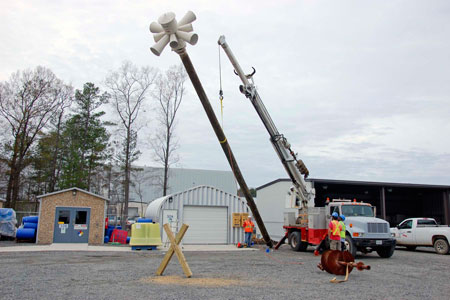 To assist in notifying members of the lab community – especially those working outdoors – of Tornado Warnings in the immediate area, a Tornado Warning Siren has been installed.
In the event of a tornado or, at or very near Jefferson Lab, taking cover as quickly as possible is the best and first-priority response action, according to Mary Logue, associate director of Jefferson Lab's ESH&Q Division. Sending emergency email and page alerts and individual work centers monitoring weather radios have been the primary notification tools at the lab. But these mechanisms don't reach everyone, or in some cases, not in a timely fashion, according to Tina Menefee, Jefferson Lab's emergency manager. To assist in notifying staff, subcontractors and visiting scientists – especially those who may be working out-of-doors or don't have immediate access to Jefferson Lab email – a Tornado Warning Siren has been installed. The installation took place on Dec. 5 and the first operational check of the system – sounding the siren – took place the next day. The Tornado Warning or "take cover" sound is a loud wavering tone – also called high-low-high or 10-4-10 – that lasts about three minutes. Jefferson Lab's siren will be tested at 12 p.m. (noon) on the first working Friday of each month, according to Menefee. Tests of the system will last less than one minute. (To hear what the siren sounds like, go to the Tornado Response Procedure, Appendix T3, in the ES&H Manual and click on the tornado icon or the "emergency warning siren" links. The siren will be sounded at 9:45 a.m. for the Tuesday, March 20 Statewide Tornado Drill. The next test of the siren is being scheduled for noon on Friday, April 6. During the first few tests of the system, the emergency manager will map how far the sound travels. According to the siren system vendor, Sirens for Cities, Inc., depending on weather conditions when the siren sounds, the tone may be heard by anyone outdoors within a 1.5-mile radius of the siren. A Jefferson Lab site-wide email will go out in advance of all scheduled tests of the system. During these tests, members of the lab community won't be expected to react to the siren. However, when the siren is activated for a drill, such as the Statewide Tornado Drill on March 20, taking appropriate action will be expected. "Testing the siren is necessary to ensure that it is functioning," Menefee notes. "It is also a good way to remind members of the lab community what the tornado warning sounds like, and reminds each and every one of us to pause for a moment and consider where we would 'take cover' if the test were a real warning." "Speed of notification and knowing where to 'take cover' are critical to saving lives during tornadoes," Menefee continues. "Using the siren is another notification tool, giving people time to seek safety. The lab will continue to send Tornado Warning and Watch email and pager alerts, and lab managers encourage all work centers to install and use an emergency alert weather radio. The siren is a nice addition to our notification system." For more information about Jefferson Lab's Tornado Response Procedure, visit Chapter 3510, Appendix T-3 in the ES&H Manual at: http://www.jlab.org/ehs/ehsmanual/3510T3.htm |
Volunteers Needed for May 19 JLab Open House; Sign up is Underway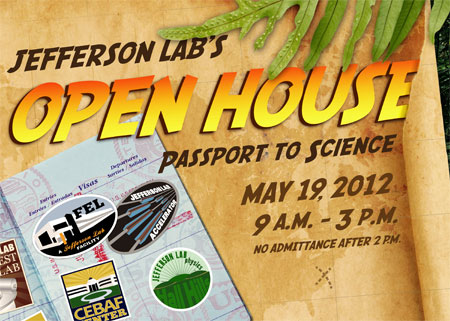 Volunteer sign-up is underway for Jefferson Lab's May 19 Open House. Volunteers are needed to help with a variety of tasks designed to provide the public with a safe, fun and educational experience at the event. Sign up online through April 16.
Jefferson Lab's Open House is just around the corner, and this year's event will be bigger than ever, says Michelle Lechman, Open House planning committee chair. "Not only are we anticipating more than the 7,000 visitors we had last time, we also have much more to show visitors with Hall D, the TED (Technology and Engineering Development building) and the Test Lab Addition open this year," she adds. "That means we need more volunteers than in past years in order to provide the public with a safe, fun and educational experience. To make it easy and convenient, we have created an online sign up for all volunteers." Volunteer sign-up to help with the lab's 2012 Passport to Science Open House is underway and will continue through April 16. Hourly employees will be paid, with advance approval from their supervisors. Sign up online at: http://www.jlab.org/openhouse/volunteer.html. Each volunteer will receive a T-shirt to wear while at the Open House. When signing up, be prepared to provide your T-shirt size and your cell phone number. There will be mandatory volunteer briefings scheduled by functional areas. The sign up webpage lists volunteer positions by work location and functional assignment. Most positions offer morning and afternoon shifts for the Saturday, May 19, event. If you plan to work all day, be sure to sign up for a morning shift and an afternoon shift. Staff and users are encouraged to sign up as soon as possible. You may sign up adult family members, and your children over age 13 for volunteer positions that don't require JLab safety training. A JLab login is required to access the volunteer webpage. Volunteers leading tours or staffing displays or activities for specific programs or locations should consult with that area's volunteer coordinator. Area volunteer coordinators are listed with taskings on the web sign up page. Please direct general-event volunteer questions to Open House Volunteer Coordinator Tina Menefee, ext. 5490, cell 768-4030 or email menefee@jlab.org. JSA Grant Winner Takes Aim at Never-Before-Seen State of Matter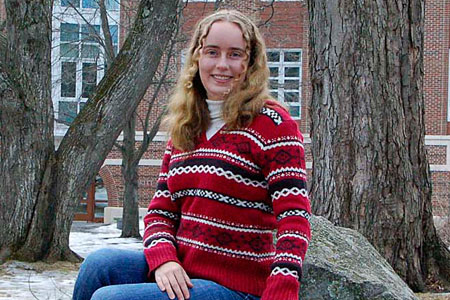 Sarah Phillips, a research scientist at the University of New Hampshire and a member of Jefferson Lab's user community, was named recipient of the 2012 Jefferson Science Associates Postdoctoral Research Grant. Photo by Daniel Mannarino
Very few people can claim to be the first to see a new state of matter. Sarah Phillips wants to join those select few. Phillips took a step closer to that goal when she was named the recipient of the 2012 Jefferson Science Associates Postdoctoral Research Grant in mid-February. Phillips, a research scientist at the University of New Hampshire, was selected for the grant by the Jefferson Lab Users Group Board of Directors, the governing body of the group that represents the scientists who use lab facilities to conduct research. In making the award, the board judged each applicant on his or her record of accomplishment in physics, proposed use of the research grant and the likelihood of further accomplishments in the research fields pursued at Jefferson Lab. "Now in its 5th year, the JSA Postdoctoral Research Grant competition has once again attracted outstanding candidates who proposed truly innovative and unique projects to be funded by the prize money. The User Group Board of Directors had a difficult choice to make – we wish we could have funded them all!" said Sebastian Kuhn, users group board chairman and a professor of physics at Old Dominion University. "Jefferson Lab has many outstanding scientists. We are pleased to support Sarah's research and all of us look forward to the results from her challenging experiment," said Hugh Montgomery, JSA president and Jefferson Lab director. Phillips will use the $10,000 grant to build a piece of equipment for an experiment to see a predicted, but never-before-seen state of matter called true muonium. True muonium can be thought of as a rare atom made out of two particles that are similar to electrons, called muons. Muons are produced high above Earth when cosmic rays strike the atmosphere. Two types of muons, a muon and an antimuon, combine to form true muonium. "It's quite rare. And I think that's probably why it hasn't been observed before. Unless you were specifically looking for it, you'd just completely miss it," Phillips says. She hopes to add the search for true muonium to an existing experiment that will slam energetic electrons from Jefferson Lab's CEBAF accelerator into a target made of tungsten to produce heavy photons, which are particles that may interact with dark matter. According to theoretical calculations, this experiment is also likely to produce true muonium. "We're expecting to only produce around 100 or 150 in the standard setup. It seems that you can produce more if you change your target to optimize it for true muonium, so that's what the proposal is for: To try to optimize it so that we can make more of the true muonium atoms, to have a better chance at not only proving them, but trying to study them," Phillips explains. The project's unique focus impressed the board, according to Kuhn. "In the end, the proposal by Sarah Phillips stood out because it appeared to be literally a 'one-person project' that pushes a completely new experimental initiative. The board also noted Sarah's outreach efforts and her role in inspiring younger students," Kuhn said. Phillips says mentoring the next generation of scientists is an important part of her duties at the University of New Hampshire, and she looks forward to working daily with students in the lab. "For a lot of them, it's the first time that they actually get to do any research. They really get the opportunity to get their hands dirty and do some things in the lab, and they just love it," she says. Phillips earned her B.S. in physics at Mississippi State University and her M.S. and Ph.D. at The College of William & Mary. The JSA Postdoctoral Research Grant has been awarded annually since 2008 by the Users Group Board of Directors. The research grant is one of the funded projects of the JSA Initiatives Fund program, provided annually by the owners of JSA to support programs, initiatives, and activities that further the scientific outreach, and promote the science, education and technology missions of Jefferson Lab and benefit the lab's user community. Information about the JSA Initiatives Fund is online at: http://www.jsallc.org/IF/IFIndex.html By Kandice Carter Lab Selects Physicist Patrizia Rossi as Deputy AD for Nuclear Physics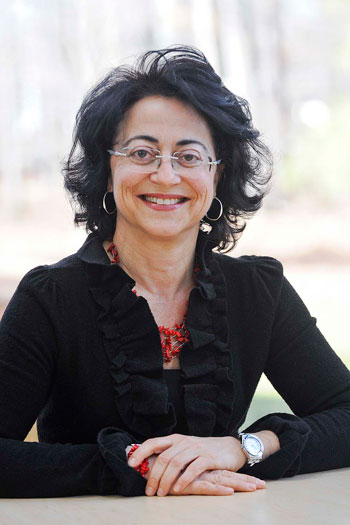 Patrizia Rossi has been named deputy associate director for nuclear physics at Jefferson Lab. She will begin her duties at the lab in May.
Patrizia Rossi, a well-respected physicist from Italy with extensive experience in experimental physics, has been named deputy associate director for nuclear physics at Jefferson Lab. Rossi, a senior staff scientist at Laboratori Nazionali di Frascati of Istituto Nazionale di Fisica Nucleare (LNF-INFN), will begin her duties at Jefferson Lab in May. "Patrizia is an outstanding scientist and a valuable addition to the lab," said Jefferson Lab Director Hugh Montgomery in announcing the selection of Rossi in February. "She brings experience as a manager and extensive knowledge of Jefferson Lab, which will greatly benefit our research efforts as we prepare for the future and the start of our 12 GeV experimental program." Since 2003, Rossi has served as co-spokesperson and LNF coordinator of the Italian participation at Jefferson Lab. The Italian collaboration is fully involved in the 12 GeV program. Rossi also has served as chair of the service work committee in Jefferson Lab's experimental Hall B since 2004 and has been a member of the Hall B technical and ad hoc committees since 2002. In March 2010, she also served as a member of the lab's Program Advisory Committee, a panel of leading scientists that selects experiments to be run at the lab. Rossi received a degree in physics from the University of Rome in 1986. In 1988, she received a fellowship from INFN to conduct research and then joined the Frascati National Laboratory as a staff researcher in 1990. Her research has focused on studying the structure of the nucleon and the strong force, areas of major emphasis at Jefferson Lab. In addition to Jefferson Lab and laboratories in Italy, Rossi also has conducted experiments at DESY Laboratory in Hamburg, Germany and the ESRF Laboratory in Grenoble, France. Rossi is a referee for such publications as Physics Letters B, Nuclear Physics A, European Physics Journal A, Israel Science Foundation, Applied Radiation and Isotopes, and Science & Technology Facilities Council (UK). She also has been a collaborator on more than 160 refereed journal papers, and has served as a member of numerous conferences and workshops, including those in Italy, Russia, Armenia and Romania. "Patrizia will be of tremendous value to the overall nuclear physics program at Jefferson Lab, in terms of Physics Division planning, optimizing collaboration and productivity, and increasing JLab science visibility. I am mightily pleased that she chose to join us," said Rolf Ent, associate director for nuclear physics. "This is an exciting time to join Jefferson Lab as it grows and becomes an ever more interesting place to do research," Rossi said. "The 12 GeV Upgrade is a reality and is providing a challenge to develop new ideas and proposals to the science program. I am looking forward to becoming part of this dynamic effort." Lab Signs MOU With the China Institute of Atomic EnergyJefferson Lab's Deputy Director of Science and Technology, Robert McKeown, while in Beijing in July 2011 signed a collaborative agreement – a memorandum of understanding – with officials from the China Institute of Atomic Energy regarding collaborative research efforts between the two institutions. The medium- and high-energy physics group at the CIAE has been collaborating with Jefferson Lab for the last decade and has participated in about 20 experiments. With the new research opportunities to be provided by JLab's 12 GeV Upgrade to the Continuous Electron Beam Accelerator Facility, China's hadronic physicists have joined their U.S. collaborators in proposing experiments for the upgraded CEBAF, including performing measurements on quark transversity, quark trans-helicity distributions and to perform parity violating electron scattering to study electron-weak physics. As a key member of the Chinese collaboration, the CIAE will be responsible for the development and construction of the central part of the GEM (Gas Electron Multipliers) detector and the GEM foils for the Solenoidal Large Intensity Detector (SoLID) apparatus to be sited in Hall A at Jefferson Lab. Lab Phone System Undergoing an Upgrade This photo shows one of the new Cisco phones being installed around the lab.
Across Jefferson Lab, new telephone handsets are appearing, and eventually the entire system will be updated. The lab's legacy phone system, which is decades old and has not had a full maintenance contract since 2008, is well beyond its anticipated life, according to Bryan Hess, telecommunications manager. "The deployment of a new phone system is underway and is being driven in large part by the new construction taking place around the lab" he explained. "We needed to be able to install new phones in all the new locations, but the existing system was not adequate to support lab growth and the 12 GeV era." The upgrade will support new facilities including the Technology and Engineering Development Facility, and the 12 GeV Upgrade which includes the new Hall D complex and the new support buildings. A multi-disciplinary action team convened to study the options, and sought out information and feedback on telecommunications systems used at other Department of Energy labs before making the decision to use Cisco’s Voice-over-Internet Protocol system – commonly called VoIP. "It allows us to install both phones and networking using a single cable to the desktop," Hess said. "Because resources are tight, the transition to the new phone system has turned into a multi-year project," he continued. "It's not ideal, but it allows us to make slow progress. In between new installations, we are gradually replacing the old phones in offices and work centers around the lab." The upgrade project began in August of 2010; and as of December 2011, telecommunications had installed nearly 500 VoIP phones and was able to shutdown the old VARC telephone switch, one of the lab's four phone system switches. By early February this year, the project was about 25 percent complete. The new system offers a number of benefits for the lab, including common cabling, better systems management and integration with other network services. Information about the voice-over-IP phones is available on the Computer Center webpage (https://cc.jlab.org/). Click on the Telecom tab and scroll down to VoIP and select VoIP FAQ (https://cc.jlab.org/voipfaq). To report Jefferson Lab telecommunication problems: select Telecom Request under the Telecom tab on the Computer Center webpage or go to the IT Division's work request (CCPR) system and fill out the CCPR fields and select Telecom Problems in the Category field, or send an email to helpdesk@jlab.org. New Calendar and Email System to Debut in the SpringSometime this spring, your smartphone may get even smarter: Members of Jefferson Lab's Information Technology Division plan to roll out a new, combined calendar and email system that will sync with Android- and iOS-based smartphones. Senior Unix System Administrator Paul Letta, says the new system will replace Jefferson Lab's current CorporateTime calendar system and, for many users, the nuts and bolts of the lab's email system. "We want to make the system better," Letta says. "Zimbra is currently a widely used email and calendar collaboration suite. It's a much more modern suite of tools, and it has the potential to remain relevant for a long time. It'll also better keep up with increasing demands on email size and email storage." Letta says not everyone will be migrated to Zimbra. The system is needed for the roughly 600 people who use the current Jefferson Lab CorporateTime calendar system on a regular basis. "What we really want to replace is our calendar server. We will move the people that use the calendar into Zimbra," Letta explains. "But if you don't use the calendar, nothing's going to change for you. You're going to stay on the old email system. If you don't have a calendar account now, you won't have a calendar account later." The new system is already being used by a group of about 40. The beta testing allows Letta and his colleagues to iron out any bugs. Once beta testing concludes, more calendar users will be migrated onto the system. "We're going to do a behind-the-scenes migration of email accounts into Zimbra, where people will have to make a slight change to their Thunderbird configuration once they're migrated. But, other than that, it'll look just the same as it does now," Letta said. Calendar users that use other email clients have nothing to fear: their email clients will work with the new email system, too. Letta says the migration to the new system won't happen overnight. First, calendar users will be slowly migrated to the email portion of the new Zimbra system. After all of these users have been migrated, training will be offered on how to use the new calendar. Then, the calendar portion of Zimbra will be migrated for everyone at once. While calendar users can choose to continue using their existing email interface, they will only be able to access the calendar though the new Zimbra web interface. The Zimbra web interface will allow calendar users to access their email and calendar in the office and from home in one, robust interface. Letta says the biggest difference for some will be in performance. Zimbra should markedly speed up the delivery of emails to your inbox. Non-calendar users will also see improvement in email response as more users are moved off of the old email system and onto Zimbra. Kelvin Edwards, Systems Team Manager, says the new Zimbra system is a culmination of a year of researching and testing systems to find the best fit for lab staff and Users. The IT Division's Letta, Edwards and Sherman White all made major contributions to the procurement, testing and implementation of Zimbra. "We looked at several other combined email and calendar systems and Zimbra is certainly cheaper than any of them, does at least as good a job, and we can manage it in-house," Edwards says. "A lot of people are using mobile devices now. Zimbra allows you to integrate your Jefferson Lab calendar with your mobile device's calendar app. The current calendar server doesn't allow you to do that." Edwards says further testing of the system will take several more weeks, with a full rollout planned for the spring. "There will be a bit of a learning curve with the new calendar system, but once you've learned it, it will be a much nicer and more modern system," Edwards says. Information about Zimbra is available on the Computer Center webpage at: https://cc.jlab.org/zimbra Teachers Invited to April 11 Science Activities Night at JLab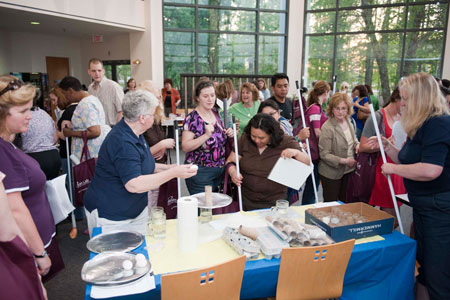 Teachers participated in hands-on science activities and received resource materials at Jefferson Lab's 2011 Teachers Night. The event focused on physical science activities that teachers of fourth- through eighth-grade classes can use in the classroom. The 2012 Teachers Night is scheduled for April 11.
Elementary- and middle-school teachers interested in learning new and innovative methods for teaching the physical sciences are being invited to attend the annual Region II Teacher Night, scheduled for Wednesday, April 11, at Jefferson Lab. The event will focus on physical science activities that teachers of fourth- through eighth-grade classes can use in the classroom. The evening's format will imitate a science fair. But instead of students showing off their science projects, more than 50 teachers will share their favorite or most-effective classroom activities with other teachers. The presenting teachers will provide handouts and many will have free teaching supplies to accompany the handouts. Activities will cover a range of topics, including friction, electrolysis, the water cycle, engineering design challenges, exothermic demonstrations, energy conservation, electricity, polymers, scientific investigation, science games, sound, force and motion, the periodic table, diffraction, the solar system, static electricity, renewable energy, and compounds and mixtures. Teacher Night will run from 6:30 to 8 p.m. in Jefferson Lab's CEBAF Center, located at 12000 Jefferson Ave., Newport News. To reserve a spot, or for more information, contact Brita Hampton no later than Wednesday, April 4; email hampton@jlab.org or call 757-269-7633. "The teachers presenting activities and demonstrations at Science Night are former and current participants in a teacher enrichment program conducted at the lab," notes Lisa Surles-Law, a Jefferson Lab Science Education administrator. "They will be sharing many of the activities they have used in their classrooms. These teachers have spent a great deal of time and energy learning new science and teaching methods, and they want to share them with the larger teaching community." "More than 100 teachers attended each of the four previous events," Surles-Law adds. "Teacher Night is a great opportunity for sharing and learning and finding something new to take back to the classroom." The teacher enrichment program, dubbed JLab Science Activities for Teachers, and this teacher workshop are supported by the JSA Initiatives Fund, a grant program funded annually by Jefferson Sciences Associates, LLC. An informational flyer, including driving instructions may be downloaded at: http://education.jlab.org/teachernight/flyer.pdf. For additional Teacher Resources visit Jefferson Lab's science education website. TJHS Wins Feb. 4 Virginia Science Bowl; Princess Anne Takes Second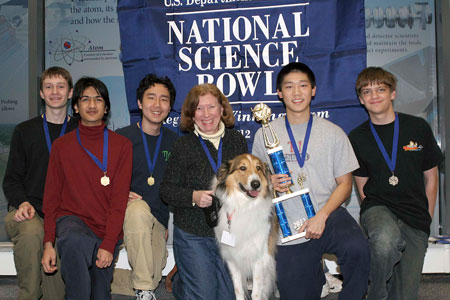 Thomas Jefferson High School for Science and Technology, from Alexandria, won the Feb. 4 Virginia Regional High School Science Bowl. Pictured, left to right, are Owen Grey, sophomore; Kalki Seksaria, junior; Zemming Lin, senior; Coach Sharon Webb; Yuqing Zhang, senior; and Alec Brenner, junior.
Competition was intense among the 22 schools vying for top honors at the Virginia Regional High School Science Bowl held at Jefferson Lab on Feb. 4. The Thomas Jefferson High School for Science and Technology team from Alexandria defended its title as the reigning Virginia champ. The team answered its way through the morning round-robin matches and the double-elimination playoffs in the afternoon undefeated. The TJHS team squared off against the Princess Anne High School team from Virginia Beach in Round 6 of the semi-finals, and gave the Virginia Beach team its first loss of the afternoon. This resulted in a final rematch between the two teams that ended with TJHS winning 56 to 4. With a string of difficult Toss-Up questions and grueling Bonus questions, the less experienced Princess Anne team found it difficult to score. The TJHS team used strategy and knowledge to pull ahead, and earned most of its points on the Toss-Up questions. The TJHS team, led by Coach Sharon Webb, included three veteran team members. The Princess Anne team, coached by Clare Ellen Kerr, included four new team members and only one returning team member. Following TJHS and PAHS in third place was the Langley High School team from McLean. And the Piedmont Governor's School for Math, Science, and Technology team from Danville finished in fourth. For finishing first, the TJHS team won an expense-paid trip to the U.S. Department of Energy Science Bowl Nationals to be held in Washington, D.C., April 26-30. The team also took home a $750 check for its school, the regional banner that the team will carry to nationals, a team trophy and individual medals. 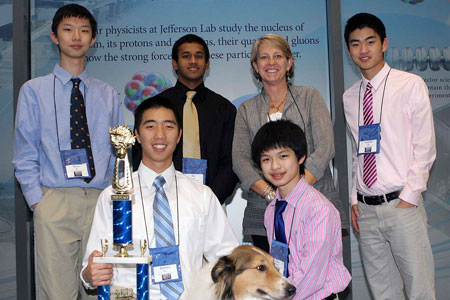 The Princess Anne High School team from Virginia Beach finished in second place at the Virginia High School Science Bowl. Pictured, back row, left to right, are Kevin Hu, sophomore; Kal Shah, senior; Coach Clare Ellen Kerr; and Richard Lee, senior, and in the front, l. to r., are Andrew Kim, senior, and Gary Chen, sophomore.
The Princess Anne team received a $500 check for its school and a team trophy. The Langley High School team, coached by Leah Puhlick, earned a $300 check for its school and a team trophy. And the Piedmont Governor's School team, coached by Susan Propst, took home the fourth-place team trophy. The National Science Bowl tournament – sponsored by the Department of Energy since 1991 – is an annual competition among teams of students. The teams face off in an intense question-and-answer format where contestants are quizzed on their knowledge in all science disciplines, including earth and space science, biology, chemistry, general science, and physics as well as mathematics. Teams that didn't advance to the afternoon semi-finals were invited to compete in a problem-solving challenge dubbed the Stay All Day Contest. Teams were presented with a design challenge and an engineering challenge. The team with the best combined results for the two activities was Woodbridge Senior High School from Woodbridge and coached by Kathy Voehl. Team members won individual prizes and received a $300 check for their school. "The Science Bowl program champions an interest in science, technology, engineering and math among our nation's youth," said Jan Tyler, Jefferson Lab's Science Education manager. "It encourages students to further their education and to pursue careers that will use this knowledge." The efforts of more than 55 volunteers were needed to carry out the day-long event. Most of the volunteers were Jefferson Lab staff members who performed as competition moderators, scientific and rules judges, timekeepers and scorekeepers during matches. Robert McKeown, the lab's deputy director for science and technology, kicked off the event with a welcome address to the students, coaches and family members in the auditorium. Milestones for Jan. - Feb. 2012Hello Goodbye These Milestone entries, listed alphabetically, are full-time, term, casual and student actions posted by Human Resources for January and February 2012. Jefferson Lab is seeking qualified individuals for a range of technical, engineering and scientific positions. College student summer co-op positions are currently listed. All current employment opportunities are posted at: [Link Removed] Lab Mourns Passing of Osamu Hashimoto, Close Friend & Scientific Collaborator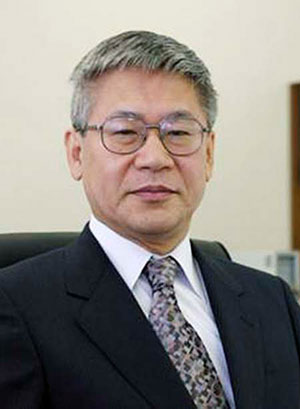 Osamu Hashimoto
Tohoku University Osamu Hashimoto, a professor at Tohoku University in Japan, passed away on Feb. 3 in Sendai, Japan, after a long and courageous battle with pancreatic cancer. He was 64. He will be missed by his colleagues and friends around the world, and especially by his colleagues in the community of scientists studying strangeness in nuclear physics. His work in this area, particularly at KEK and Jefferson Lab, resulted in many important contributions to the field that are well recognized and will be well remembered. Osamu received his Ph.D. from the University of Tokyo. He became an assistant professor in 1975 and then an associate professor in 1986 at the university’s Institute for Nuclear Study (INS). He was a leader of the KEK hypernuclear physics program for many years. Among his many contributions to the program was the design and construction of the SKS spectrometer, which was used for a broad range of hypernuclear physics experiments, including mass spectroscopy using the (p+,K+) reaction, and studies of the weak decay and g-ray spectroscopy of hypernuclei. The SKS spectrometer was moved from KEK to the J-PARC hadron hall and now serves as the main spectrometer for the strangeness physics program there. In 1995, Osamu became a full professor at Tohoku University and led the nuclear physics group there in a major involvement in the Jefferson Lab program of electro-production of hypernuclei. This program began with the HNSS, the first high precision electro-production spectroscopy experiment, which completed data taking in 2000. Having demonstrated the feasibility and promise of the electro-production of strangeness, he then set out to push this approach to its ultimate limit, proposing the construction of a pair of dedicated spectrometers (the HKS and HES) for the "HKS experiments" (E01-011 and E05-115). He obtained funding from Japan (>$6M) for this instrumentation, and played a strong leadership role in the construction of the apparatus, its installation at Jefferson Lab and its use in carrying out proposed measurements. Osamu also made many contributions to education at Tohoku University, beginning with his research group and continuing while serving as chair of the Physics Department, dean of the Graduate School of Science and vice president of the university. He was a believer in international exchange in science, as can be seen from his group’s involvement at Jefferson Lab and elsewhere, and his service as the executive director of the Center for International Exchange at Tohoku University. But perhaps most of all, the many people who had the pleasure and privilege of working with Osamu will remember him as an outstanding scientist who valued and recognized the contributions of each person on the large teams needed for major experiments, such as the HKS. We can never forget his kindness and friendship, his enthusiastic and dedicated spirit, and his many contributions to our science. His funeral was held in Sendai on Feb. 7 (vigil ceremony) and 8 (funeral ceremony). Osamu's many friends in the Jefferson Lab community are planning to create a modest memorial to him in the form of a cherry tree planted near the Hall C counting house. There also will be a plaque inside the counting house identifying the tree as a memorial to him and to his many contributions to our science and the international community of nuclear physicists. A remembrance by friends and collaborators Lab Mourns Passing of John Brawley, Retired Staff Member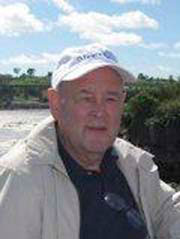 John Brawley
Jefferson Lab, Retired John Brawley, 73, retired Jefferson Lab staff member and respected colleague, died on March 9 due to pulmonary fibrosis, his wife, Peggy, was at his side. He was born Aug. 8, 1938, in Sheffield, England, raised in Glasgow, Scotland, and came to America with his mother in 1951. They resided in Elmira, N.Y., where Brawley graduated from Elmira Free Academy. He served in the U.S. Navy from 1957-1961. Upon an honorable discharge, he was employed by the Mitre Corporation in Bedford, Mass., and attended Lowell Technological Institute. He worked at Cornell University, Ithaca, N.Y., in the Nuclear Studies Department from 1964 until 1987. At that time, he and his family relocated to Virginia, where he worked for Jefferson Lab (then CEBAF) as the electron beam welder in the SRF group. Upon retiring in 2003, he and his wife moved to Gloucester. Brawley was among the founding members of KirkWood Presbyterian Church, Yorktown, where he served as an ordained Elder. In Gloucester, he was an active member of First Presbyterian Church. A celebration of life service, conducted by the Rev. Dr. Douglas Nagel and the Rev. Dr. Michael Condrey, will be held at 2 p.m. Sunday, March 18, at First Presbyterian Church, Gloucester. A reception will follow the service in the fellowship hall. In lieu of flowers, memorial donations may be made to Gloucester Volunteer Fire and Rescue, P.O. Box 1417, Gloucester, VA 23061; Riverside Walter Reed Hospital Hospice, P.O. Box 1130, Gloucester, VA 23061; or to the Building Fund of First Presbyterian Church, P.O. Box 581, Gloucester, VA 23061. Andrews Funeral Home, Gloucester, Va., is in charge of arrangements. View and post condolences on the online guestbook at dailypress.com/guestbooks. This notice was excerpted from the obituary notice published in Daily Press at: http://www.legacy.com/obituaries/dailypress/obituary.aspx?n=john-brawley&pid=156460021 Cold Box Gets Warm Welcome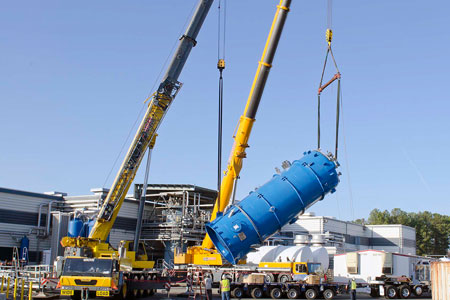 Jefferson Lab staff heralded the arrival of the first of two Cold Boxes, needed to upgrade the CEBAF accelerator's refrigeration plant, after it arrived at the lab on March 7. The 100,000 pound cylindrically shaped system, made by Linde Corporation, made its debut just before mid-day. It had taken about a week to transport the 38 ft. long, 11.5 ft in diameter system cross country from the Port of Catoosa, just east of Tulsa, Okla., on a carriage system supported by 54 tires and pulled by a semi tractor. Over the course of several hours after its arrival at the back entrance to the Accelerator Site, the Cold Box had to be transferred to a Goldhofer transport trailer with 48 tires mounted on 16 hydraulically controlled and rotatable axles – so that it could be delivered to the south side of the Central Helium Liquefier, or CHL. Two heavy-lift rated cranes – one for 300 tons and one for 120 tons – were used to lift and move the Cold Box. After the switch, the transport trailer and both cranes moved to the back side of the refrigeration plant, where the cranes then lifted and moved the Cold Box into place. This unit and a second Cold Box will provide the additional refrigeration capacity necessary for CEBAF to operate at 12 GeV, or 12 billion electron volts. The second Cold Box departed the Linde production plant in Oklahoma on March 7 and is scheduled to arrive at the lab during the week of March 12; when subcontractors and lab engineering, accelerator and facilities management staff will repeat the delivery and installation process undertaken with the first Cold Box. A Cold Box cools and purifies compressed helium for distribution and liquefaction, then warms the return flow to the compressors. The CHL provides the cryogenic refrigeration needed to cool the accelerator's superconducting radiofrequency components that are used to accelerate the high-precision electron beam for experiments. |
|
The On Target newsletter is published monthly by the Thomas Jefferson National Accelerator Facility (Jefferson Lab), a nuclear physics research laboratory in Newport News, Virginia, operated by Jefferson Science Associates, LLC, for the U.S. Department of Energy's Office of Science. Possible news items and ideas for future stories may be emailed to jlabinfo@jlab.org, or sent to the Jefferson Lab Public Affairs Office, Suite 15, 12000 Jefferson Avenue, Newport News, VA 23606
|


 Tiny flashes of light deep beneath a mountainside have revealed a quantity that relates to how neutrinos may change into other varieties. The measurement has implications for understanding our early universe and is made possible by decades of nuclear physics research.....
Tiny flashes of light deep beneath a mountainside have revealed a quantity that relates to how neutrinos may change into other varieties. The measurement has implications for understanding our early universe and is made possible by decades of nuclear physics research..... Last year, 51 tornadoes hit Virginia, the second highest number on record. Ten people died, more than 100 were injured, and 212 homes and 17 businesses were destroyed......
Last year, 51 tornadoes hit Virginia, the second highest number on record. Ten people died, more than 100 were injured, and 212 homes and 17 businesses were destroyed...... In the event of a tornado or, at or very near Jefferson Lab, taking cover as quickly as possible is the best and first-priority response action, according to Mary Logue, associate director of Jefferson Lab's ESH&Q Division.....
In the event of a tornado or, at or very near Jefferson Lab, taking cover as quickly as possible is the best and first-priority response action, according to Mary Logue, associate director of Jefferson Lab's ESH&Q Division.....